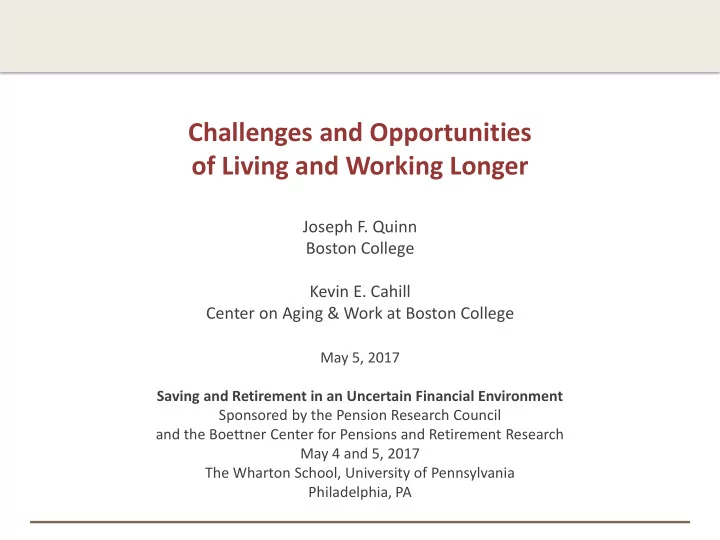

Challenges and Opportunities of Living and Working Longer Joseph F. Quinn Boston College Kevin E. Cahill Center on Aging & Work at Boston College May 5, 2017 Saving and Retirement in an Uncertain Financial Environment Sponsored by the Pension Research Council and the Boettner Center for Pensions and Retirement Research May 4 and 5, 2017 The Wharton School, University of Pennsylvania Philadelphia, PA
Outline The new world of retirement income security in America: many causes for concern Are older Americans prepared for retirement? What might concerned potential retirees do? Are they doing it? Key outstanding questions Joseph F. Quinn and Kevin E. Cahill 2 of 18
Shares of aggregate income for aged units 65 or older, by source, 2014 Note : Totals do not necessarily equal the sum of the rounded components. Aged units include married couples with a least one person aged 65 or older and nonmarried persons aged 65 or older. Source : US Social Security Administration (2016b). Joseph F. Quinn and Kevin E. Cahill 3 of 18
Social Security tax revenues and outlays with scheduled and payable benefits, 1985 to 2085 Source : Congressional Budget Office (2016). CBO’s 2016 Long -Term Projections for Social Security: Additional Information. Washington, DC: US Government Printing Office. https://www.cbo.gov/sites/default/files/114th-congress-2015-2016/reports/52298-socialsecuritychartbook.pdf. Joseph F. Quinn and Kevin E. Cahill 4 of 18
Private-sector participants in an employment- based retirement plan, by plan type, 1979 to 2011 Source : Employee Benefit Research Institute. FAQs about benefits – retirement issues. Washington, DC: Employee Benefit Research Institute. Downloaded March 10, 2017 at http://www.ebri.org/publications/benfaq/index.cfm?fa=retfaqt14fig2. Joseph F. Quinn and Kevin E. Cahill 5 of 18
Federal spending as a percentage of GDP by component, 2000 to 2045 Notes : a Consists of spending on Medicare (net of offsetting receipts), Medicaid, and the Children’s Health Insurance Program, as well as outlays to subsidize health insurance purchased through the marketplaces established under the Affordable Care Act and related spending. b Consists of all federal spending other than that for Social Security, the major health care programs, and net interest. Source : Congressional Budget Office (2016), Figure 1-2. Joseph F. Quinn and Kevin E. Cahill 6 of 18
Mean retirement account savings of families by age, 1989 to 2013 Note : 2013 dollars. Retirement account savings include 401(k)s, IRAs, and Keogh plans. Source : Morrissey (2016). Joseph F. Quinn and Kevin E. Cahill 7 of 18
The National Retirement Risk Index 1983 to 2013 Source : Munnell (2015a), Figure 2. Joseph F. Quinn and Kevin E. Cahill 8 of 18
Options for concerned potential retirees An individual has no control over: Social Security, Medicare, or Medicaid reform; e mployers’ decisions regarding pension coverage; or pension type or post-retirement health insurance. The potential for additional saving at older ages is limited (it’s too late!). What can one do? Joseph F. Quinn and Kevin E. Cahill 9 of 18
Labor force participation rates: men 60-64 actual and fitted values, 1964 to 2015 Source : Authors’ calculations based on US Bureau of Labor Statistics, Employment and Earnings. Joseph F. Quinn and Kevin E. Cahill 10 of 18
Labor force participation rates: women 60-64 actual and fitted values 1964 to 2015 Source : Authors’ calculations based on US Bureau of Labor Statistics, Employment and Earnings. Joseph F. Quinn and Kevin E. Cahill 11 of 18
Labor force participation rates: men, by age 1950 – 1985 and 1985 – 2016 Source : US Bureau of Labor Statistics. Joseph F. Quinn and Kevin E. Cahill 12 of 18
Labor force participation rates: women, by age 1970 – 1985 and 1985 – 2016 Source : US Bureau of Labor Statistics. Joseph F. Quinn and Kevin E. Cahill 13 of 18
Shares of aggregate income, by source selected years Notes: Totals do not necessarily equal the sum of the rounded components. Source : US Social Security Administration (2016). Income of the Aged Chartbook: 2014. Washington, DC: SSA. https://www.ssa.gov/policy/docs/chartbooks/income_aged/2014/iac14.pdf Joseph F. Quinn and Kevin E. Cahill 14 of 18
For most, retirement is a process , not an event Source : Cahill, Kevin E., Michael D. Giandrea, and Joseph F. Quinn. 2015 . “Retirement Patterns and the Macroeconomy, 1992 – 2010: The Prevalence and Determinants of Bridge Jobs, Phased Retirement, and Re- entry among Three Recent Cohorts of Older Americans.” The Gerontologist; 55(3), 384-403; doi: 10.1093/geront/gnt146. Joseph F. Quinn and Kevin E. Cahill 15 of 18
Some outstanding questions To what extent does bridge employment increase labor supply over the retirement transition period? How do bridge jobs compare with the career jobs that older workers leave behind? How can society address some of the challenges associated with hiring and retaining older workers (e.g., age discrimination and the cost of employee benefits)? Joseph F. Quinn and Kevin E. Cahill 16 of 18
Some outstanding questions ( continued ) To what extent are low interest rates masking the financial instability of older Americans with substantial debt and suppressing the urgency of continued work later in life? For savers, is the low-return environment altering appetites for risk in order to achieve higher returns? Joseph F. Quinn and Kevin E. Cahill 17 of 18
Conclusion The implications of societal aging will depend in large part on how we respond to the challenges and opportunities of living and working longer. Causes for concern: the financial outlook for Social Security, Medicare, and Medicaid the shift to DC plans in the private sector low personal savings rates Reasons for optimism: the way older Americans have responded to the retirement income challenge by staying in the labor force later in life the remarkable ability of older Americans to adjust the ways in which they work Policymakers would be wise to consider additional ways to support continued work later in life to help mitigate the challenges our aging society will face in the decades ahead. Joseph F. Quinn and Kevin E. Cahill 18 of 18
Recommend
More recommend